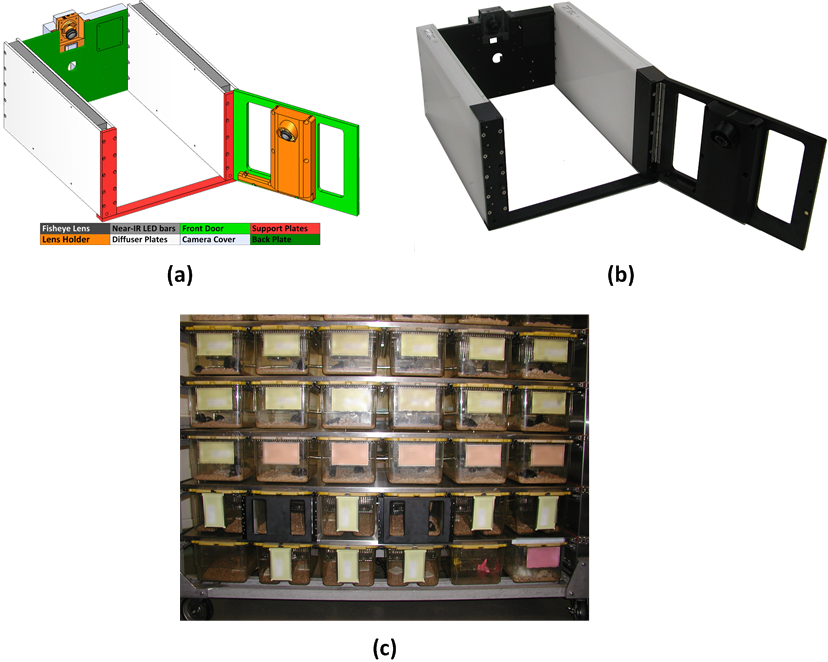Collaborators
Project Brief
In collaboration with NCI, NIDDK, NIMH, and FDA, SCORHE is designed to meet the demands of NIH IRP researchers and animal care staff to automatically assess laboratory mice ethology in large-scale settings. SCORHE is comprised of custom video-acquisition and analysis tools developed to quantify mice activity and behavior for short and long (multi-day) durations while housed within a typical home-cage. The specialized hardware was designed to be space efficient, compatible with vivarium cage racks, and animal-facility user friendly. The advanced video analytics algorithms output ethology measures such as locomotion profiles and software-interpreted behaviors. SCORHE hardware targets the ‘natural’ home-cage setting in an effort to eliminate concerns, often associated with traditional mouse monitoring methods, such as circadian rhythm disruption, acclimation periods, lack of nighttime measurements, and short monitoring periods. With mice being the predominant mammalian model used in NIH IRP research, SCORHE is the most practical solution for large-scale use of vision systems in animal facilities, affording researchers and animal care staff accurate long-term activity and well-being measures. SCORHE developments will provide the scientific community an open-source platform for consistent and repeatable acquisition of home-cage ethology measures. More than a dozen SCORHE units being fabricated will provide access to this unique technology to additional IRP investigators.
What is SCORHE?
SCORHE (System for Continuous Observation of Rodents in Home-cage Environment) is comprised of custom video-acquisition and analysis tools developed to quantify mice activity and behavior for short and long (multi-day) durations while housed within a typical home-cage. The specialized hardware was designed to be space efficient, compatible with vivarium cage racks, and animal-facility user friendly. The advanced software algorithms output ethology measures such as locomotion profiles and software-interpreted behaviors. SCORHE hardware targets the ‘natural’ home-cage setting in an effort to eliminate concerns, often associated with traditional mouse monitoring methods, such as circadian rhythm disruption, acclimation periods, lack of nighttime measurements, and short monitoring periods. Overall, SCORHE developments will provide the scientific community an open-source platform for consistent and repeatable acquisition of home-cage ethology measures.
Motivation
Behavior assessment is an integral part in drug-efficacy, animal model development, and phenotyping studies. Video-based systems have emerged as a viable solution to quantify alterations in mouse locomotion and behavior profiles. Automated video analysis carries the promise of high-throughput, long-term, and fine-grained assessment of mouse activity and behavior. The results obtained through video analysis compliment other phenotypical measures to provide researchers more insight on deviations from baseline behavior. To enable wide-spread access to video-acquisition and analysis technology in animal facilities, the SCORHE units were designed to have a minimal footprint and integrate with existing colony racks. SCORHE units can also be used outside of the cage-racks. SCORHE space efficiency and automated video analysis makes SCORHE suitable for large-scale, long-term use with minimal user intervention.
Collaboration
SCORHE design, fabrication, evaluation, and deployment is a collaborative effort with NIH IRP researchers. Initial developments were focused on rather limited requirements (e.g., general mouse activity) associated with specific studies. More recently, advancements in algorithm development have led to obtaining detailed time-resolved behavior measures and accurate locomotor activity profiling. Ongoing collaborations will enable immediate innovative application of SCORHE to support IRP studies. New collaborations with will likely result in further SCORHE development to extend hardware and software analysis functionality. Overall, SCORHE developments will provide the scientific community an open-source platform for consistent and repeatable acquisition of home-cage ethology measures.
Hardware
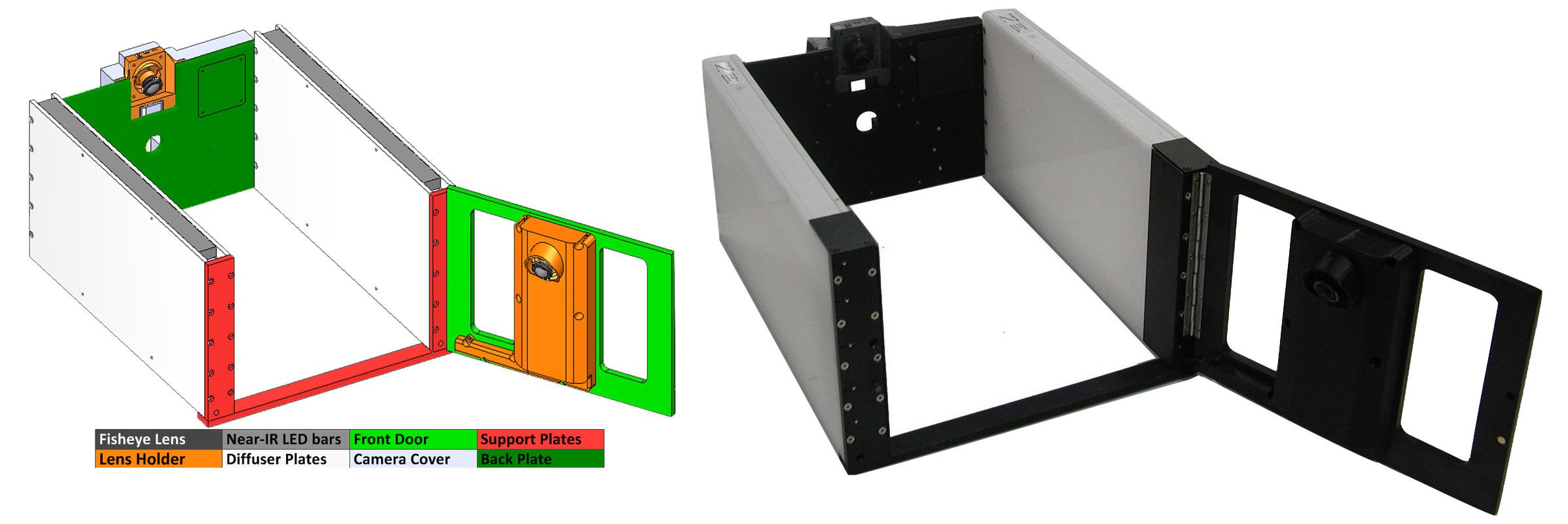
Video Acquisition
The SCORHE hardware is comprised of two to four time-synchronized cameras giving complete view of the home-cage volume. Fisheye lenses allow capture of a full cage-view with the cameras positioned in very close proximity to the cage; resulting in a compact and space-efficient unit design. The side-panels of the SCORHE unit are equipped with near-infrared emitters to provide spatially and temporally uniform illumination during video acquisition without disrupting the light/dark cycle for the mice.
In-Rack Operation
The SCORHE unit was designed to achieve seamless integration with vivarium cage-racks, which includes maintaining full rack cage capacity and providing easy access to the cage via the windowed door. The current prototypes were engineered for compatibility with the Maxi-Miser racks (Thoren Caging Systems, Hazelton, PA) predominantly found in the National Cancer Institute (NCI) animal facilities.
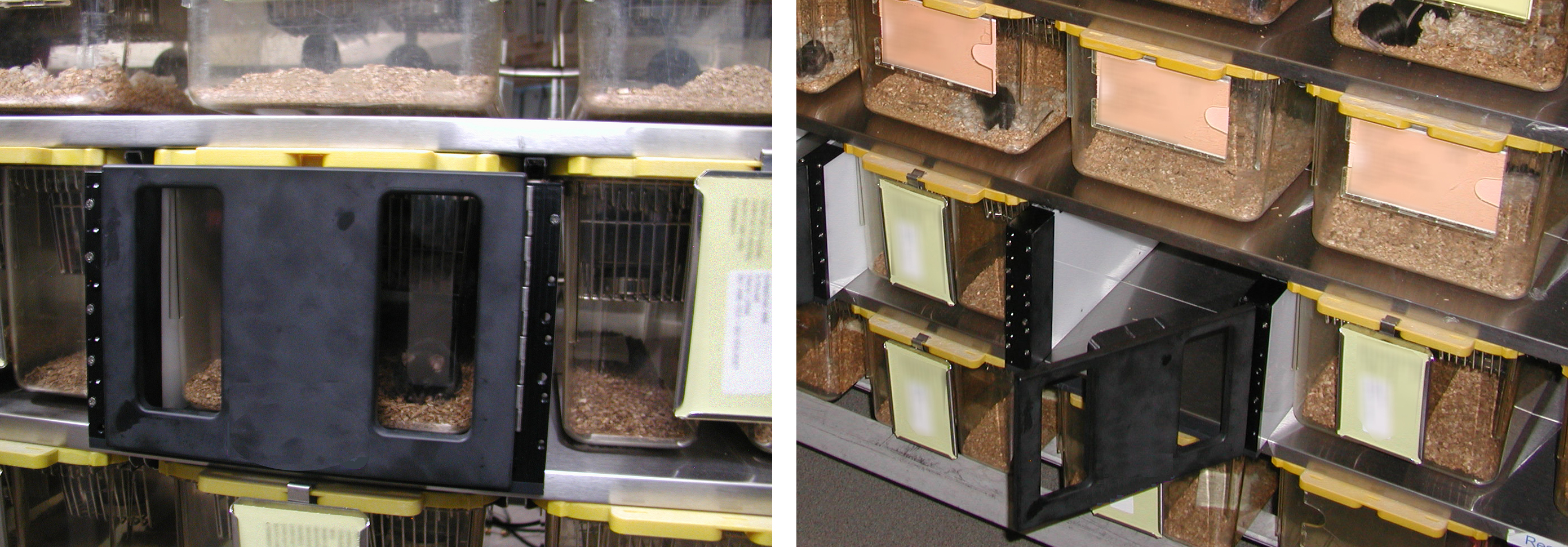
While the current SCORHE unit hardware is tailored to Thoren’s racks and Model 5 cage, the design could be modified to achieve compatibility with other racks and cage combinations. Alternatively, SCORHE units could be used as bench-top systems (i.e., outside a cage rack).
Out-of-Rack Operation
For researchers interested in using the system immediately in vivaria or laboratories not equipped with the Thoren racks, a bench-top rack solution has been designed to house four SCORHE units. The compact, open-frame system provides easy access to the units, and eliminates clutter by consolidating cables.
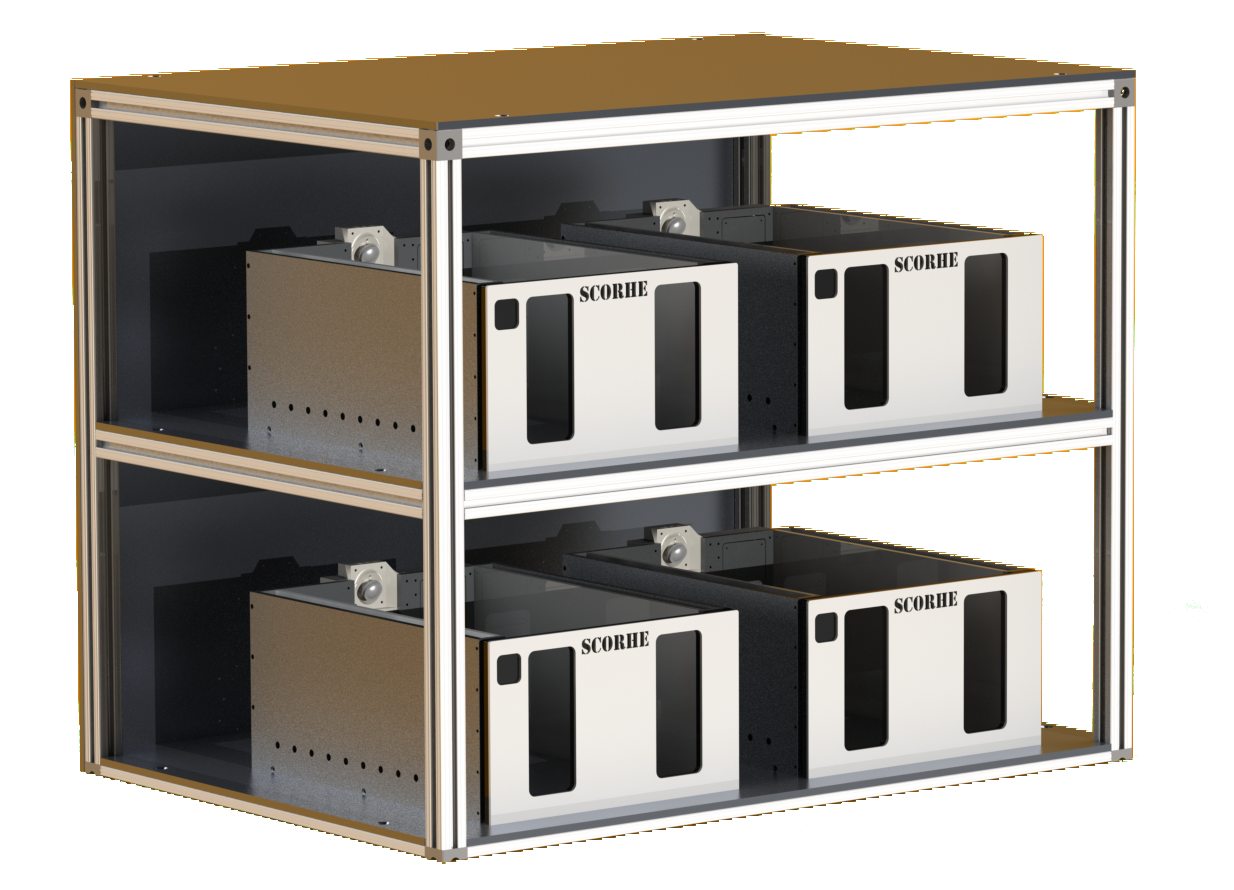
Software
Software methods have been developed to automate analysis of video acquired by the SCORHE units. The SCORHE algorithms accomplish two main tasks. The first task is estimation of mouse head/tail position. The trajectory information derived from the position estimates is used in analyzing locomotion patterns. The second is identification and labeling of bouts of nine pre-defined behaviors: eating, drinking, grooming, foraging, unsupported rearing, supported rearing, climbing, walking, and resting. The time-resolved behavior labels are used in detection of abnormalities. The algorithms are based on statistical modeling in a supervised learning scheme. Namely, for 3D head/tail estimation, mouse head/tail positions were manually marked for a large set of SCORHE images. Synchronized with each image, the actual physical head/tail positions were obtained via a parallel validation system comprised of additional cameras and corresponding perspectives. The set of annotated SCORHE images and corresponding validated physical positions was used to train a non-parametric regression model. The resulting regression model calculates the physical position of the mouse head/tail in each frame of video. The behavior detection module is posed as a classification problem with a training set comprising hours of manually labeled video. The resulting classifier incorporates temporal context from trajectory and spatial features to assign to each frame one of the nine aforementioned behavior labels. Currently, the processing rate for the software methods is slower than required for real-time operation. Videos acquired by SCORHE are analyzed offline by the software in a post-processing fashion. Refer to the video at the top of the page for example output of the SCORHE processing methods.
Results
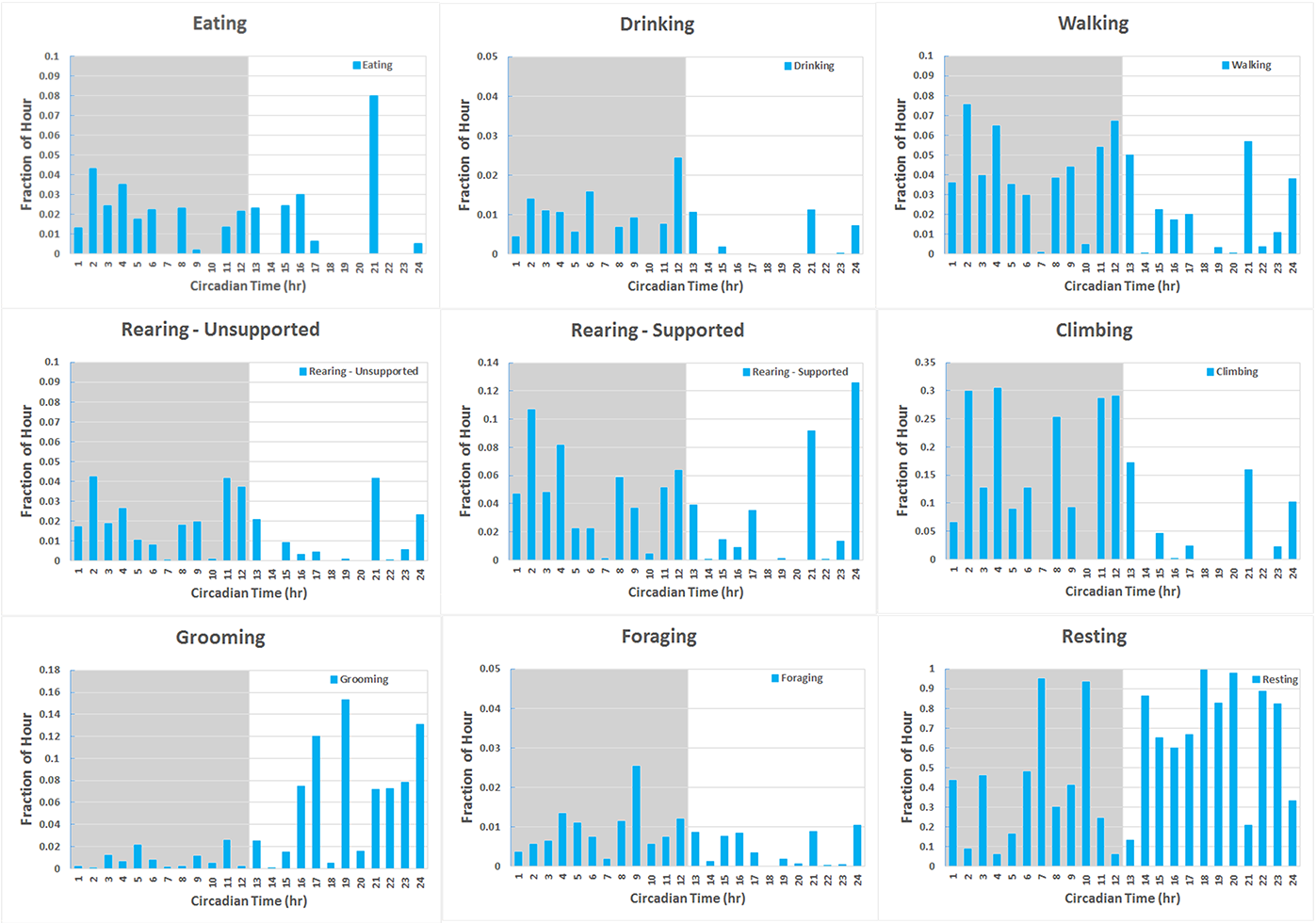
Future Development
The initial development phase targeted solitary-housed black mice. With the major hardware and software challenges resolved and a clear course for algorithm design charted, three main SCHORE development goals are currently underway. The first goal is optimization of the code to achieve real-time processing. The second is to mirror the black mouse algorithm development for other coat-colors. And the third is to extend SCORHE functionality to cages housing multiple animals.
Please contact us if you are interested in developing new SCORHE functionality and applications specific to meeting your research requirements. The video link below includes clips of multiple animals per cage that might aid in evaluating which measures could be obtained with the current SCORHE design, and those which would require SCORHE modification or further development.
